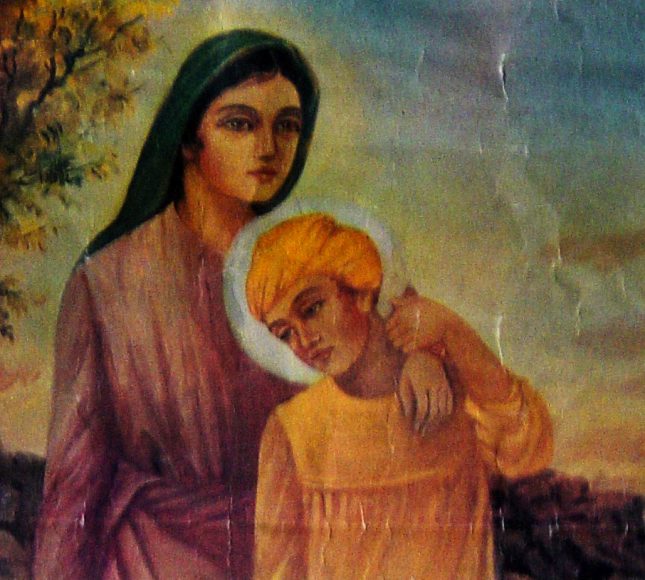NANAKI, BEBE, or Bibi Nanaki (1464-1518), elder sister of Guru Nanak and the daughter of Kalian Chand (Baba Kalu) and Mata Tripta, was born in 1464 in her mother`s home at the village of Chahal, now in Lahore district of Pakistan Punjab. Five years older than her brother, she was the first to recognize his spiritual eminence and to become his devotee. She was married in 1475 to Jai Ram, an official at the court of Nawab Daulat Khan Lodhi at Sultanpur. Herself childless, Bebe Nanaki adored her brother, Nanak, and felt herself blessed when he came to join the Nawab`s service and put up with her at Sultanpur.
She arranged his marriage, and she loved his sons, Sri Chand and Lakhmi Das, as her own. Guru Nanak reciprocated her affection and, after he had quit the Nawab`s service to go out to preach his message, he did not fail to visit Sultanpur and meet his sister between whiles. Once as he visited her in 1518, Bebe Nanaki, seeing her end near, detained him a short while. As she had wished, she departed this life in the presence of her brother Guru. Three days later, her husband, Jai Ram, also expired. Guru Nanak himself performed their obsequies.
References :
1. Bhalla, Sarup Das, Mnhima Prakash. Patiala, 1970
2. Santokh Singh, Bhai, Sri Gur Pratap Suraj Granth. Amritsar, 1927-35
3. Gian Singh, Giani, Twarikh Guru Khalsa [Reprint]. Patiala, 1970
4. Vir Singh, Bhai, Puratan janam Sakhi [Reprint]. Amritsar, 1982
5. Macauliffe, Max Arthur, The Sikh Religion. Oxford, 1909
6. McLeod, W.H., The B-40Janam-Sakhi. Amritsar, 1980
7. Harbans Singh, Guru Nanak and Origins of the Sikh Faith. Bombay, 1969
Bibi Nanaki—often respectfully called Bebe Nanaki—holds a singular place in Sikh history as the very first devotee to recognize the divine spark in her younger brother, Guru Nanak. Born in 1464 in the village of Chahal (in what is now the Lahore district of Pakistan’s Punjab region), Nanaki was five years older than Nanak. Even in her early years, she exhibited an intuitive spiritual insight that allowed her to discern Nanak’s mystical temperament and inner calling. Her early recognition emboldened her to nurture and protect him, thereby paving the way for his future as a spiritual luminary .
Growing up in a traditional Punjabi household, Nanaki’s life was steeped in familial duties and cultural customs. Despite the ordinary demands of her environment, her exceptional sensitivity to Guru Nanak’s emerging spirituality set her apart. When she was married in 1475 to Jai Ram—an official serving under the Nawab Daulat Khan Lodhi at Sultanpur—she continued her steadfast devotion to her brother. In many ways, her nurturing presence at Sultanpur provided Nanak with both sanctuary and moral support during times of familial and societal pressure, thus reinforcing his resolve to follow his unique spiritual path .
Nanaki’s role transcended that of a mere family member. Known for her protective and caring nature, she intervened on behalf of Nanak when his introspective nature conflicted with the expectations of their household. She is even remembered for a poignant incident in 1518, when sensing her own life’s end, she requested that Guru Nanak remain with her a while longer. This final, heartfelt act not only marked the culmination of her personal journey but also deepened the spiritual bond between the siblings. Her husband’s passing shortly thereafter and Guru Nanak’s decision to personally conduct their obsequies further underscore the profound influence she exerted on his life and on the nascent Sikh community .
Today, Bibi Nanaki is celebrated as more than just Guru Nanak’s elder sister. She is revered as a pioneer—a figure emblematic of unconditional faith, maternal care, and the transformative power of intuitive spirituality. Her legacy is a testament to how familial bonds, when nurtured with understanding and love, can spark movements that challenge the norms and enrich cultural and spiritual life. In Sikh tradition, her life continues to remind devotees of the importance of early spiritual guidance and the critical role that women have played in the development of the faith .
Beyond her immediate historical context, reflecting on Nanaki’s life invites us to consider the broader implications of spiritual mentorship within families and communities. Her story encourages a reexamination of how early support and recognition can empower individuals to pursue unconventional paths—a theme that remains as relevant today as it was in the 15th century. This timeless legacy invites further exploration into the intersections of familial love, gender roles, and spiritual destiny in Sikhism and other spiritual traditions.



